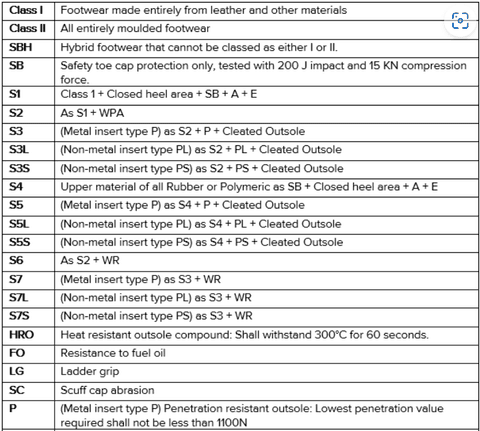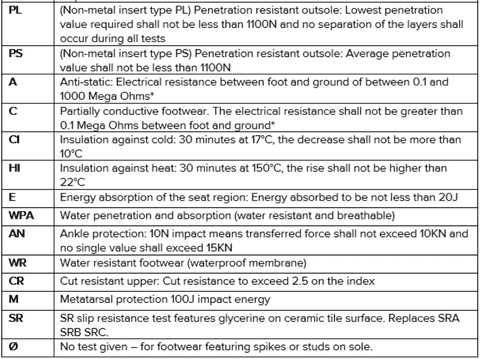
Personal safety equipment.
These international standard details basic and additional (i.e., optional) requirements for general-purpose safety footwear (e.g., mechanical risks, slip resistance, thermal risks, and ergonomic design) and for footwear designed for specific professions and worksite conditions (e.g., footwear for firefighters, electrical insulating footwear, protection against chainsaw injuries, protection against chemicals and molten metal splash, protection for motorcyclists).
EN 20345:2022 - PERSONAL PROTECTIVE EQUIPMENT - SAFETY FOOTWEAR
(EN 20345:2022 supersedes EN 20345:2011)
The EN ISO 20345 standard for safety footwear has been updated, superseding the previous 2011 update. Changes range from the requirements that footwear must meet to the test methods themselves. Some standards have therefore been revoked. It is hoped that the changes will make for more precise testing and clearer marking of safety footwear that reflect more realistic real-world conditions and modern materials.
While all changes to the standards have significance, some are aimed primarily at the manufacturers. Therefore, here we have listed some changes that will likely impact you the most:
The old slip resistance markings of SRA, SRB and SRC no longer exist. This is because slip resistance has been deemed such a crucial feature of safety footwear, and it is now considered mandatory and will not carry a mark. There is an option for an additional slip test to be carried out, which will be marked with an SR symbol.
The slip resistance test has also changed in the way it is carried out – now on a ceramic tile surface not a steel plate, and using different lubricants. Also, the heel and forepart of the boot will be tested, not the flat.
The old symbol of WRU (meaning water-resistant uppers) has been replaced by a new code of WPA – meaning water penetration and absorption.
There is a new test for the durability of the scuff cap, intended to establish its capabilities of protecting the toecap. This has a symbol of SC if it is passed (after 1,000 abrasion cycles).
A ladder grip test assess the suitability of the footwear for use on ladder rungs, and tests the area which rests on the rung (between the heel and forepart of the boot below the arch) to a firefighter standard. The symbol for passing this is LG.
The term ‘penetration resistance’ has changed to ‘puncture resistance’. If the insert is a steel plate, the markings haven’t changed, it is still P.
However, there are two test methods for NMAPI inserts, which stand for non-metal anti-penetration inserts, more commonly known as a
composite insert or insole. Of these two test methods, the difference is the diameter of the nail used for the test, to represent different
environments.
PL means the footwear was tested for general risks with a nail 4.5mm in diameter.
PS means the footwear was tested with a nail 3mm in diameter, and is relevant for risks such as sewing needles or hypodermic needles.
Crucially, a boot, shoe or trainer cannot have more than one marking, it is either P, PL or PS.

